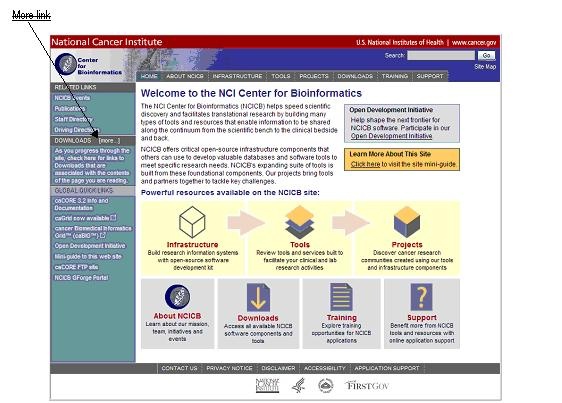 |
Page History
...
The EVS API home page provides a user interface (UI) to the Java API. The interface is available at http://lexevsapi.nci.nih.gov/lexevsapi50![]() .
.
| Info | ||
|---|---|---|
| ||
The caCORE 3.2 release also provides an EVS 3.2 Java client API. The difference between the 3.2 and the 4.x clients is the back-end terminology server. caCORE 3.2 uses the proprietary Apelon DTS and caCORE LexEVS 4.x uses LexBIG. The API is the same and should only require minor updates to a client application wanting to migrate to the EVS 3.2 Java API provided with caCORE LexEVS 5.x. |
...
- Using your browser, go to http://ncicb.nci.nih.gov
 .
. - On the left navigation bar of the NCICB welcome page, click the more link to the right of the DOWNLOADS category (Downloads section of the NCICB Web site).
- When prompted, enter your name, e-mail address, and institution name.
- Click Enter the Download Area.
- Read and accept the license agreement.
- On the caCORE LexEVS downloads page, download the EVS Zip file from the Primary Distribution section.
...
The Web services interface can be used in any language-specific application that provides a mechanism for consuming XML Web services based on the Simple Object Access Protocol (SOAP). In those environments, connecting to caCORE LexEVS can be as simple as providing the end-point URL. Some platforms and languages require additional client-side code to handle the implementation of the SOAP envelope and the resolution of SOAP types.To view a list of packages that cater to different programming languages, visit http://www.w3.org/TR/SOAP/![]() and http://www.soapware.org/
and http://www.soapware.org/![]() .
.
To maximize standards-based interoperability, the caCORE Web service conforms to the Web Services Interoperability Organization (WS-I) basic profile. The WS-I basic profile provides a set of non-proprietary specifications and implementation guidelines that enable interoperability between diverse systems. For more information about WS-I compliance, visit http://www.ws-i.org![]() .
.
On the server side, Apache Axis is used to provide SOAP-based, inter-application communication. Axis provides the appropriate serialization and deserialization methods for the JavaBeans to achieve an application-independent interface. For more information about Axis, visit http://ws.apache.org/axis/![]() .
.
Configuration
The caCORE/LexEVS WSDL file is located at http://lexevsapi.nci.nih.gov/lexevsapi50/services/lexevsapi50Service?wsdl![]() . In addition to describing the protocols, ports, and operations exposed by the caCORE LexEVS Web service, this file can be used by a number of IDEs and tools to generate stubs for caCORE LexEVS objects. This enables code on different platforms to instantiate native objects for use as parameters and return values for the Web service methods. For more information on how to use the WSDL file to generate class stubs, consult the specific documentation for your platform.
. In addition to describing the protocols, ports, and operations exposed by the caCORE LexEVS Web service, this file can be used by a number of IDEs and tools to generate stubs for caCORE LexEVS objects. This enables code on different platforms to instantiate native objects for use as parameters and return values for the Web service methods. For more information on how to use the WSDL file to generate class stubs, consult the specific documentation for your platform.
The caCORE LexEVS Web services interface has a single end point called lexevsapi50Service, which is located at http://lexevsapi.nci.nih.gov/lexevsapi50/services/lexevsapi50Service![]() . Client applications should use this URL to invoke Web service methods.
. Client applications should use this URL to invoke Web service methods.
...
The DLB environment will be configured on the caCORE LexEVS Server (http://lexevsapi.nci.nic.gov/lexevsapi50![]() ). This will give the server access to the LexBIG database and other resources. The client must therefore go through the caCORE LexEVS server to access any LexBIG data.
). This will give the server access to the LexBIG database and other resources. The client must therefore go through the caCORE LexEVS server to access any LexBIG data.
...
The Mayo Clinic wrote the LexBIG 5.0 API. Documentation describing the LexBIG Service Model is available on the LexGRID Vocabulary Services for caBIG GForge site at https://gforge.nci.nih.gov/frs/?group_id=14![]() .
.
LexBIG Installation and Configuration
...
